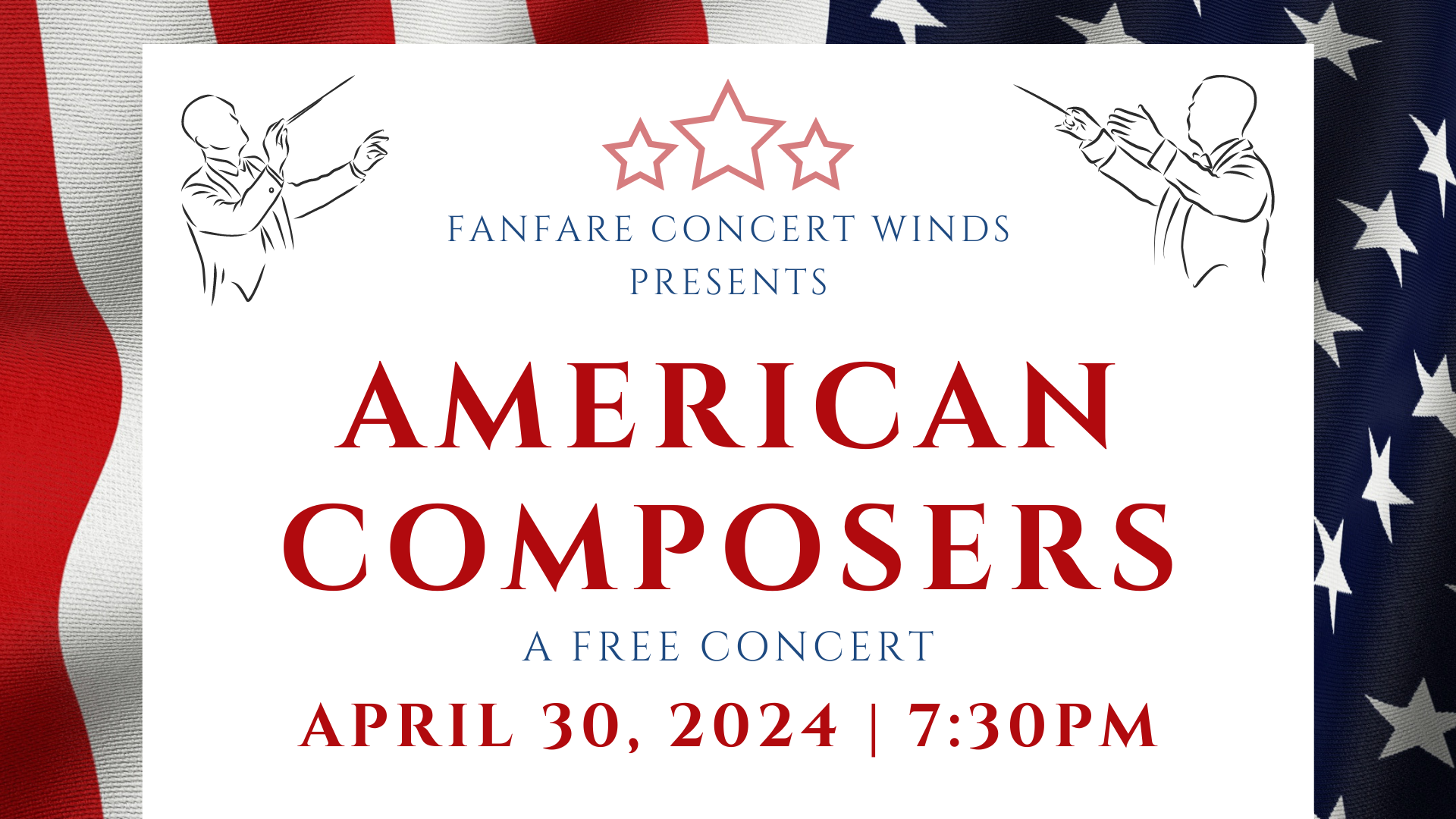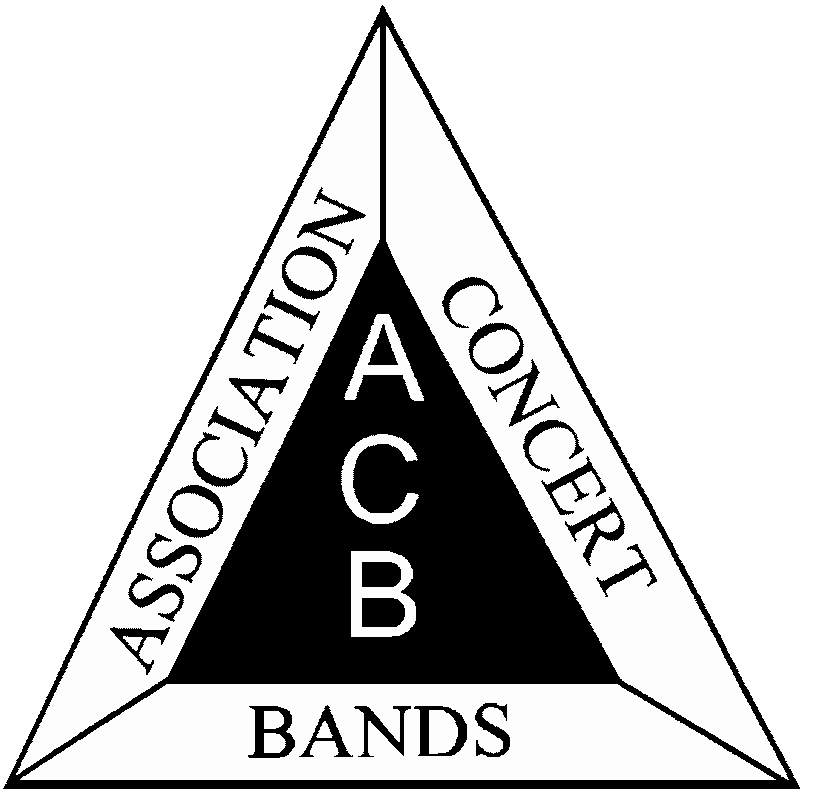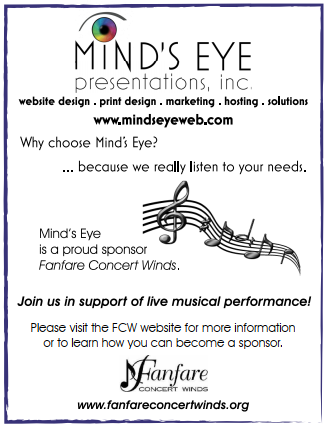
Concert Program
AMERICAN OVERTURE – Joseph Willcox Jenkins
LET ME BE FRANK WITH YOU – John Mackey
SOUTHERN HYMN – Samuel R. Hazo
SLAVA! – Leonard Bernstein/Robert Longfield
THE PROMISE OF LIVING – Aaron Copland/Ken Singleton
THE SYMPHONIC GERSHWIN – George Gershwin/Warren Barker
GRAND SERENADE FOR AN AWFUL LOT OF WINDS AND PERCUSSION – P.D.Q. Bach/Professor Peter Schicklele



Fanfare Concert Winds Members
FLUTE/PICCOLO
Kathleen Amaya Rodriguez
Helen Bailey
Amy Carrasco
Madeline Davidoff
Nancy Green
Lee Lafleur
Sarah Liebelt
Kate O’Leary
Stephanie Padron
♫ Joseph Rose
Kathryn Thorson
OBOE
Mark Mai
Veronica Jacob
BASSOON
Molly Bacon
June Hammond
Christen Hernandez
CLARINET
Dana Burt
Brandi Dean
Steven DeBoer
♫ George Linakis
Tom Lyons
Marques Rudd
Anita Smith
Jeanette Sung
ALTO CLARINET
Jose A. Ortiz
BASS CLARINET
John Horn
Cameron Jennings
ALTO SAXOPHONE
Stacey Jenkins
Joni Long
Roger Nelson
TENOR SAXOPHONE
Jon Harmon
BARITONE SAXOPHONE
♫ Alli Howard
♫ Denotes Section Leader
TRUMPET
John Acosta
♫ John Baker
Lacey Bigler
Cyndi Burchfield
Richard Crawford
Matt King
Terri Molesky
Sherlyn Padron
Roberto Plumey
Chris Shultz
John Whitaker
HORN
Philip Booth
Jordan Fraze
Jackie Hall
♫ Bradley Harp
James Mayo
JF Thomas
Cameron Tilson
TROMBONE
Sara Fraze
Mike Henry
♫ Lewis Lopez,
Walt Shaffner
BASS TROMBONE
Vince Chrisman
EUPHONIUM
Rick Hatfield
Edgar Kilborn
Emily Raines
TUBA
Douglas Barlar
James Coyne
Daniel Hadden
♫ Leigh Simonton
Robert Singelton
PERCUSSION
♫ Steve Brown
Tim Diehl
D.J. Harpole
Sam Koppelman
Manuel Rosadilla
Jae Xiong
PIANO
Kathy Baker
Conductor Ted M. Hope has served as the conductor of the Fanfare Winds and Hillsborough Community College for the past 10 years. He was affiliated with the Hillsborough County School District for 39 years and retired as the Supervisor of Middle and Secondary Music after 19 years of service in March of 2023. He received his Associates Degree from Hillsborough Community College, Bachelor of Music Education from Florida State University, and his Master of Music Education and Education Specialist from the University of Southern Mississippi. He subsequently taught in the public schools for twenty years as band director at Hillsborough High School (1984-1987) and Bloomingdale High School (1987-2004). He is a member of the Florida Bandmasters Association where he served as chairman and secretary. Mr. Hope’s professional affiliations include Music Educators National Conference, Hillsborough County Secondary Music Council, Phi Mu Alpha Sinfonia, the Bay Area Saxophone Quartet and the Hillsborough Association of School Administrators. Mr. Hope is an active clinician and adjudicator in concert band, jazz ensemble, and marching band.
Program Notes
American Overture – Joseph Willcox Jenkins
A long-established staple of the band repertoire, American Overture was written in 1953 for the US Army Field Band. Its slightly unorthodox instrumentation reflects the personnel of the ensemble for which it was composed. With the encouragement of the American Bandmasters Association, Jenkins embarked on this composer-supervised critical edition 50 years after the work’s premier. Aside from the inclusion of a full score, there are many corrections and authentic revisions to dynamics, articulations, and pitches. Jenkins earned Bachelor’s and Master’s degrees from the Eastman School of Music. His military service followed, serving on the arranging staff of the Army Field Band in Fort Meade, Maryland. It was in this capacity that he composed American Overture to showcase the superb horn section.
Let Me Be Frank with You – John Mackey
In the summer of 2020, in the midst of COVID, I desperately felt like I needed to write something joyful. So, I started writing, and after about 24 measures, I had this terrible feeling – not uncommon for composers, that maybe the piece I was writing had already been written. This work is zany and energetic and is perfect for adding a lighter touch to your concert. An active percussion section, fun extended techniques, mutes, and abundant energy make this piece a blast! The composer dedicates this work to Frank Ticheli because, at some points, it sounds like he wrote it!
Southern Hymn – Samuel R. Hazo
The original themes used in this beautiful setting are intended to be played in the style of a slow Southern folk hymn, similar to Amazing Grace or Shenandoah. Using suspensions and resolutions as well as calm moments and powerfully emotional builds, this is a marvelous work for expanding your ensemble’s stylistic and dynamic range. Mr. Hazo has been a music teacher at every educational grade level from kindergarten through college. He received his bachelor’s and master’s degrees from Duquesne University. He continues to write for Hal Leonard, Boosey & Hawkes, FJH Music and Wingert-Jones Publications.
Slava! – Leonard Bernstein/Robert Longfield
When Mstislav Rostropovich (“Slava” to his friends) invited Leonard Bernstein to help him launch his inaugural concert as Music Director of the National Symphony Orchestra, he also asked him to write a rousing new opening piece for the festivities. This overture is the result, and the world premiere took place on October 11, 1977, with Rostropovich conducting his orchestra at the Kennedy Center for the Performing Arts in Washington, D.C.
The first theme of Slava! is a vaudevillian razz-ma-tazz tune filled with side-slipping modulations and sliding trombones. Theme two, which prominently features a canonic tune in 7/8 time. A very brief kind of development section follows, after which the two themes recur in reverse order. Near the end they are combined with a quotation (proclaimed by the ubiquitous trombones) from the “Coronation Scene” of Mussorgsky’s Boris Goudonov, where the chorus sings the Russian word “Slava!”, meaning “glory!” In this way, of course, the composer is paying an extra four-bar homage to his friend Slava Rostropovich, to whom this overture is fondly dedicated.
The Promise of Living – Aaron Copland/Ken Singleton
The Promise of Living (1954) is a quintet that unites hobos and family at the end of the first act of his only full-length opera, The Tinder Land, in celebration of the harvest and its traditions. Even without voices, the use of the folk hymn Zion’s Walls and Copland’s transparent scoring create a clear dramatic sequence. A dramatic gesture gives way to a quiet, lyrical passage, in which the gentle rise and fall of the melody suggests the unfolding sequence of wistful thoughts. Woodwinds gradually interject to create a sense of dialogue, both internal and, eventually, external.
The answer comes, this time fuller, building to a passage that is signature Copland: a smooth melody rooted in open harmonies, with bits of short, repeated motives in call and response style which keep the music moving. Brass eventually join the scene, their chorale style underscoring the ritualistic role of the moment without losing the introspective quality that draws together community and individual, past and present.
Mesa Dances – Gavin Lendt
The people of the Southwest and its beautiful and majestic landscapes serve as the inspiration for this energetic work. Motivic repetition, relentless percussion, and dramatic dynamic effects paint a picture of the desert mountains underneath a cerulean sky. With a keen sense of orchestration, this is an exciting piece.
The Symphonic Gershwin – George Gershwin/Warren Barker
The Symphonic Gershwin contains three familiar works:
An American in Paris is a “rhapsodic ballet”, inspired by an overseas trip in 1928. An opening section is followed by a rich “blues” with strong rhythmic undercurrent as an American visitor, perhaps after strolling into a cafe, succumbs to the spasm of homesickness. In a code, the spirit of the music returns to vivacity and bubbling exuberance, taxi horns contributing to the street noises and atmosphere.
Rhapsody in Blue was first performed by the Paul Whiteman Orchestra in 1924 with Gershwin playing the as-yet-unscored piano part “from the music in my mind.”
Cuban Overture embodies the polyrhythmic essence on the rumba with the unique percussive aspects of the island’s music.
George Gershwin (1898-1937) was a gifted American writer of popular songs, musical comedies, a folk opera, and other art music. With his brother Ira as lyricist, he wrote over a dozen successful musical comedies. He successfully blended popular and classical music.
Grand Serenade for an Awful Lot of Winds and Percussion – P.D.Q. Bach/Professor Peter Schicklele
Throughout recorded history there have been certain composers that have stood far above their peers in terms of their contributions to musical literature. Fortunately, P.D.Q. Bach (1807-1742??) never achieved this status. Unfortunately, Professor Peter Schickele rediscovered one of P.D.Q. ‘s deservedly obscure works and adapted for band. Thanks to the untiring editing style, who has rendered the work now playable by modern concert band, audiences can now marvel at the misbegotten meanderings of Mr. Bach and shake their collective heads, wondering “What was he thinking?” Trying to realize the composer’s intentions is a waste of time, since he probably didn’t have any. On the other hand, rehearsing the music well does seem advisable, so that when the inevitable critical backlash develops, the performing organization can justly claim that it wasn’t their fault. This act of scholarship should not set the modern concert band movement back by more than 50 years or so! In all seriousness, this has become a classic novelty selection for better bands!
Patrons
Benefactor
Brown & Brown Insurance
D&L PC Support
Forest Hills
Jerry Krumbholz
Mind’s Eye Presentations, Inc
Gold
Bruce Bursack
Dana Burt
Debora Felton
(in memory of Lee Felton)
Silver
Michael and Patty Bleau
Jim Burge
Friendship Class at Lake Magdalene United Methodist Church
John Harp Realty
Lori Ledbetter
Music Showcase
Rosann Guiggino Garcia
Paul and Nancy Prine
University of Tampa
Vivien Keen
(in memory of Bobbie Keen)
Platinum
John and Mary Ann Acosta
Anonymous
Carollwood Cultural Center
Harp-Hawkins Vacation Homes
Kenneth Schwartz
Joe and Mary Jane Stagi
United Tube
Platinum
Joni Long
Gloria and Rosie Stagi
(in memory of Joe Stagi)
Kathryn Thorson
Dawn White
Bronze
Alli Howard Tampa Realty
Andrew Altman
Ian Crumpton
Jacqueline DeBeer
Debbie Eisenstadt
Mark Frederick
Emily Garrett
Bradley Harp
Tina Hill
Niki Holmes Kantzios
Aaron Kaplan
Kay Kleinhample
Andrew Krupski
Terri & Hank Molesky
Dale A. Roberts
Larry Smith
Sally C. Spencer
Yajaira Suarez
Amy Tramer
Carmel vanHoek
Gregory Vass
John Walker
George Zucker
We now accept donations on our website via PayPal.
https://fanfareconcertwinds.org/sponsor/
Sponsors

Instruments of change
The old phrase “All boats rise with the tide” really applies to the mission of Instruments of Change. Learning to play a musical instrument improves academic performance on many levels. By teaching a child to play a musical instrument, you change their potential for success. Your investment in the children of today sets in motion a series of positive changes that echo throughout our community. Things you can do to help us:
• Please consider donating a new or gently used musical instrument.
• If you can play a few notes, you can begin teaching a child to play.
• Make a financial donation. You can make a difference in our ability to help.
Our Mission: To profoundly impact the lives of disadvantaged children through the gifts of musical instrument donation, instruction and performance.
www.InstrumentsOfChange.com ~ 813-315-9762
About Fanfare Concert Winds
The Fanfare Concert Winds has earned its reputation as the premier hybrid community/college band in Tampa Bay through a combination of exceptional musicianship, community engagement, and a commitment to musical excellence. One key factor is the band’s unique blend of talented musicians, comprising both seasoned community members, current and former music teachers, and dedicated Hillsborough Community college students. This diverse composition brings together individuals with a wide range of musical experiences and backgrounds challenging a rich and dynamic ensemble that appeals to a broad audience.
The band’s commitment to musical excellence is evident in its rigorous rehearsal schedule and the pursuit of challenging repertoire. Under the direction of skilled conductors, section leaders, and instructors, Fanfare Concert Winds consistently delivers performances that showcase both technical proficiency and emotional depth. This dedication to artistic achievement not only enhances the musicians’ skills but also elevates the overall musical experience for the audience, contributing to the band’s recognition as one of the best in the Tampa Bay region.
Community engagement and education plays a pivotal role in the Fanfare Concert Winds’ success. The band actively promotes new teacher involvement and educational outreach programs. This action only strengthens the ensemble’s connection with area band directors by “building their resilience”, but also with its audience while promoting a sense of pride and unity among its members. By serving as cultural ambassadors in the Tampa Bay area, the Fanfare Concert Winds has become an integral part of the community, further solidifying its reputation as the top hybrid community/college band in the region.
Fanfare Concert Winds would like to thank Ken Hanks, Chair of Visual and Performing Arts, and Ruthie Nelson, Director of Choral Activities of Hillsborough Community College for their encouragement and support.
Support Fanfare Concert Winds
Fanfare Concert Winds is a “Not for Profit” Organization. That means that all donations to our organization are 100% tax deductible.
Please consider a donation to Fanfare Concert Winds to help defray the cost of music.
Our tax number is 47-49031478.
You can give a check tonight (see Dana or Ted) OR:
You can mail a check to:
Fanfare Concert Winds
9465 Forest Hills Place
Tampa, FL 33612
Thank you for attending tonight’s concert!
VISION
The Fanfare Concert Winds will contribute to the musical culture and community throughout Hillsborough County by providing quality music performance and educational experiences for the young and the young at heart.
MISSION
• To facilitate a venue for music educators, professional and community musicians and Hillsborough Community College students to come together in a professional-level ensemble.
• To supplement the music education of the Hillsborough County Public Schools and Hillsborough Community College through clinics, side-by-side concerts, festivals and scholarships.
• To expose our members and audiences to quality musical literature.